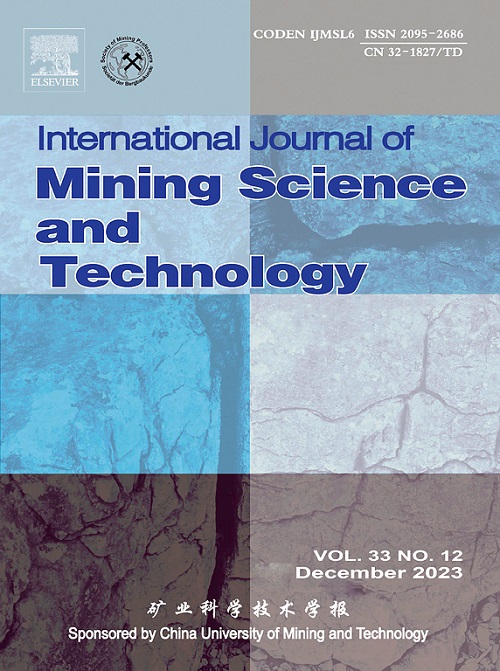Failure mechanisms and mechanical behavior of wedge-containing tunnel roof rock mass under biaxial loading
IF 13.7
1区 工程技术
Q1 MINING & MINERAL PROCESSING
International Journal of Mining Science and Technology
Pub Date : 2025-07-01
DOI:10.1016/j.ijmst.2025.06.002
引用次数: 0
Abstract
The stability of underground tunnel roofs is strongly influenced by wedge blocks formed by complex joint networks. The mechanical behavior and failure mechanisms of different roof wedge blocks in arched holes were investigated under biaxial stress conditions. The crack evolution and failure modes of the specimens were analyzed through acoustic emission (AE), digital image correlation (DIC), and discrete element method (DEM). Results show significant variations in mechanical properties: specimens T1 (extremely unstable triangular) and T2 (extremely unstable quadrilateral) exhibited higher strength than T3 (extremely stable triangular) and T4 (extremely stable quadrilateral), while support more effectively enhanced the strength of T3 and T4. Failure modes were classified as rock-dominated, wedge-dominated, or co-dominated. Cracks typically initiated near the wedge and propagated outward. Unsupported specimens developed tensile cracks at the hole bottom, shear cracks at the sides, and mixed cracks along wedge boundaries, whereas supported specimens mainly exhibited cracks at the roof and sides. Stress analysis indicated that unsupported conditions induced high stress differences, promoting localized shear failure. Wedge geometry significantly affected shear stress redistribution at the roof. These findings highlight the critical role of support and wedge block geometry in controlling stress distribution and failure mechanisms in arched tunnels.
双轴荷载作用下含楔巷道顶板岩体破坏机理及力学行为
复杂节理网络形成的楔块体对地下巷道顶板的稳定性影响很大。研究了双轴应力条件下拱洞不同顶板楔块体的力学行为及破坏机理。采用声发射(AE)、数字图像相关(DIC)和离散元法(DEM)分析了试件的裂纹演化和破坏模式。结果表明:试件T1(极不稳定三角形)和T2(极不稳定四边形)的强度高于T3(极稳定三角形)和T4(极稳定四边形),而支架更有效地增强了T3和T4的强度。破坏模式分为岩石主导、楔形主导和共同主导。裂纹通常在楔形附近开始并向外扩展。无支护试件在孔底发育拉伸裂缝、孔边发育剪切裂缝、沿楔形边界发育混合裂缝,而有支护试件主要在顶板和孔边发育裂缝。应力分析表明,无支护条件会导致较大的应力差,促进局部剪切破坏。楔体几何形状对顶板剪应力重分布有显著影响。这些发现强调了支护和楔块几何形状在控制拱式隧道应力分布和破坏机制方面的关键作用。
本文章由计算机程序翻译,如有差异,请以英文原文为准。
求助全文
约1分钟内获得全文
求助全文
来源期刊

International Journal of Mining Science and Technology
Earth and Planetary Sciences-Geotechnical Engineering and Engineering Geology
CiteScore
19.10
自引率
11.90%
发文量
2541
审稿时长
44 days
期刊介绍:
The International Journal of Mining Science and Technology, founded in 1990 as the Journal of China University of Mining and Technology, is a monthly English-language journal. It publishes original research papers and high-quality reviews that explore the latest advancements in theories, methodologies, and applications within the realm of mining sciences and technologies. The journal serves as an international exchange forum for readers and authors worldwide involved in mining sciences and technologies. All papers undergo a peer-review process and meticulous editing by specialists and authorities, with the entire submission-to-publication process conducted electronically.
 求助内容:
求助内容: 应助结果提醒方式:
应助结果提醒方式:


